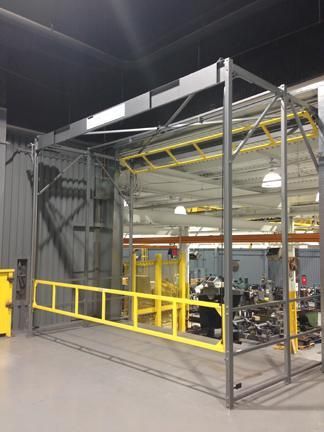
Fall Protection on Production Platforms
Production platforms, especially those that feature hoppers or mixers, can pose serious safety risks for employees working around them. These platforms, which are extremely common in food and chemical production plants, are often elevated so material can be loaded from the top and mixed as they drop into the kettle below.
Depth is often limited in these areas; pallets of ingredients are unloaded close to the hopper so employees can easily dump the ingredients without having to carry the heavy bags too far. Available height on the platform is also often limited; platforms are designed to line up with the large hoppers, often close to the ceiling where overhead pipes restrict available height even further. Maximizing space is important on elevated platforms, but is especially significant on production platforms because you must account for the equipment on the platform, the material being loaded and the room required for employees to open the sacks or pallets of ingredients and empty them into the hopper.
Production platforms pose great risk for falls because employees are emptying pallets right at the ledge, and these environments can be either uncomfortably hot or cold, the air and the platform dirty with the dust of the ingredients or slippery from material spilled on the deck or with solutions used to clean the environment. In addition, employees are often lifting heavy bags in tiring, repetitive work. In these environments, safety precautions should operate automatically so it does not depend on the actions of the employees, because they may forgot to do something while performing their tiring, repetitive tasks. The best way to secure these elevated production areas is to install a dual-gate safety system that will maintain a barrier at the ledge at all time, either behind the pallet when the pallet is being loaded or removed, or at the ledge when the worker is picking from the pallet and moving it to the hopper.
Often on production platforms the best solution is our Tri-Side model safety gate; it uses a support structure only fourteen inches deep and a three-sided rear gate that lifts up and out of the way when the ledge gate is closed, allowing access around the pallet from all sides.
One of our customers had this type of application but the area’s available height was extremely limited due to the height of the platform and the location of overhead pipes. The hopper was located off to the side, ninety-degrees from where the material was being loaded. The customer wanted the other sides of the area to be permanently secured by guardrail so the area could only be accessed from this side. Because of the height limitations, the Tri-Side was ruled out for this application as the rear gate on that design needs room to raises up and out of the way.
This scenario excited us because none of our standard gate designs would fit this footprint, requiring us to design a new solution, and our engineers like challenges. All of our other safety gate systems use gates that are interconnected so one gate moves along with the opposite counterbalanced gate, but for this solution we designed a dual-gate systems with gates that operate independently but can only be opened if the opposite gate is in the correct position. This design ensured a barrier would be in place at all times.
Specifically, we designed a sliding gate for the ledge of the platform and a swinging personnel egress gate on the side for employee access. The sliding gate could only be operated from behind the personnel egress gate at a safe distance from the ledge, and this side egress gate could only be opened when the sliding gate at the exposed ledge was closed. This dual-gate system provided the fall protection on the new production platform, allowed ninety-degree access to the sides of the pallet and fit in the available depth and height limitations.
This system was provided in powder-coated mild steel for this particular customer but could have been made in an all stainless steel construction. We also could have positioned the gates in various configurations depending on the workflow.
Remember, production platforms may provide unique challenges but they need to be made safe. And if you find yourself with a unique application please contact us. Hopefully one of our standard designs won’t fit so we can design a new solution specifically for you and the safety of your employees.